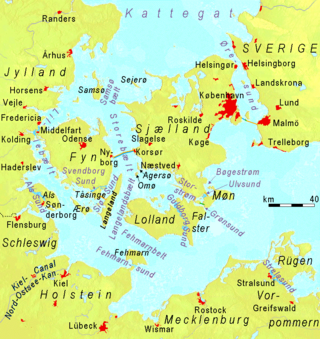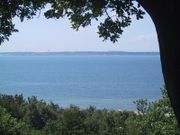Øresund

The Sound (locally known as Sundet, Danish Øresund or Swedish Öresund), is the strait that separates the Danish island Zealand from the southern Swedish province of Scania. Its width is just 4 kilometres (2.5 mi) at the narrowest point between Elsinore, Denmark, and Helsingborg, Sweden. The strait has also lent its name to the Øresund Region of 3.7 million inhabitants on both the Danish and Swedish sides.
Øresund is one of the three Danish Straits that connects the Baltic Sea to the Atlantic Ocean via Kattegat, Skagerrak and the North Sea, and is one of the busiest waterways in the world.
The Öresund Bridge was inaugurated on 1 July 2000, by King Carl XVI Gustav of Sweden and Queen Margrethe II of Denmark. Ferries run around the clock between Helsingborg, Sweden and Helsingør, Denmark.
Contents |
Streams, animals and salinity
Øresund, being at the border between oceanic salt water (with a salinity of more than 30 PSU) and the Baltic sea (only 3 to 7 PSU) has rather unique water conditions. The streams are very complex, but the surface stream is often northbound (from the Baltic sea) which gives a lower surface salinity, though streams can change from one day to another. The average surface salinity is about 10-12 PSU in the southern part but above 20 PSU north of Elsinore. At the bottom of the sea, conditions are more stable and salinity is always oceanic (> 30 PSU) below a certain depth that varies between 10 and 15 meters. In the southern part, however, the depth is just 7-10 meters, and this is the definite border of oceanic salt water, therefore also a border for many maritine species of animals. In the central Baltic Sea only 52 known salt-water species resided compare with around 1500 in the North Sea. Close to 600 species are known to exist in at least some part of Øresund. Well-known examples include lobster and the burning jellyfish (of Cyanea Artica); the latter can sometimes drift into the southwest Baltic sea, but it cannot reproduce there.
History
Political control of Öresund has been an important issue in Danish and Swedish history. Denmark maintained military control with the coastal fortress of Kronborg at Elsinore on the west side and Kärnan at Helsingborg on the east, until the eastern shore was ceded to Sweden in 1658. Both fortresses are located where the strait is just 4 kilometers wide.
In 1429 King Eric of Pomerania introduced the Sound Dues which remained in effect for more than four centuries, until 1857. Transitory dues on the use of waterways, roads, bridges and crossings were then an accepted way of taxing which could constitute a great part of a state's income. The Sound Dues remained the most important source of income for the Danish Crown for several centuries, thus making Danish kings relatively independent of Denmark's Privy Council and aristocracy.

Notable islands
- Amager
- Saltholm
- Ven (also spelled Hven)
- Peberholm - an artificial island
- Middelgrundsfortet - an artificial island
- Flakfortet - an artificial island
- Gråen - a semi artificial island outside port of Landskrona
See also
- Öresund Region
- Öresund Bridge
- Danish straits
- Great Belt
- Øresund station on the Copenhagen Metro
References
- Menefee, Samuel Pyeatt, "The Sound Dues and Access to the Baltic Sea" in Renate Platzoder and Philomene Verlaan (eds.), The Baltic Sea: New Developments in National Policies and International Co-Operation (1996), pp. 101-32.
External links
- Øresunddirekt - Official public information site for the inhabitants of the Øresund region
- Øresund Trends - An official public information site with up-to-date information on the region, available in English
- Øresundstid - The History of the Øresund Region (English, Swedish, Danish)